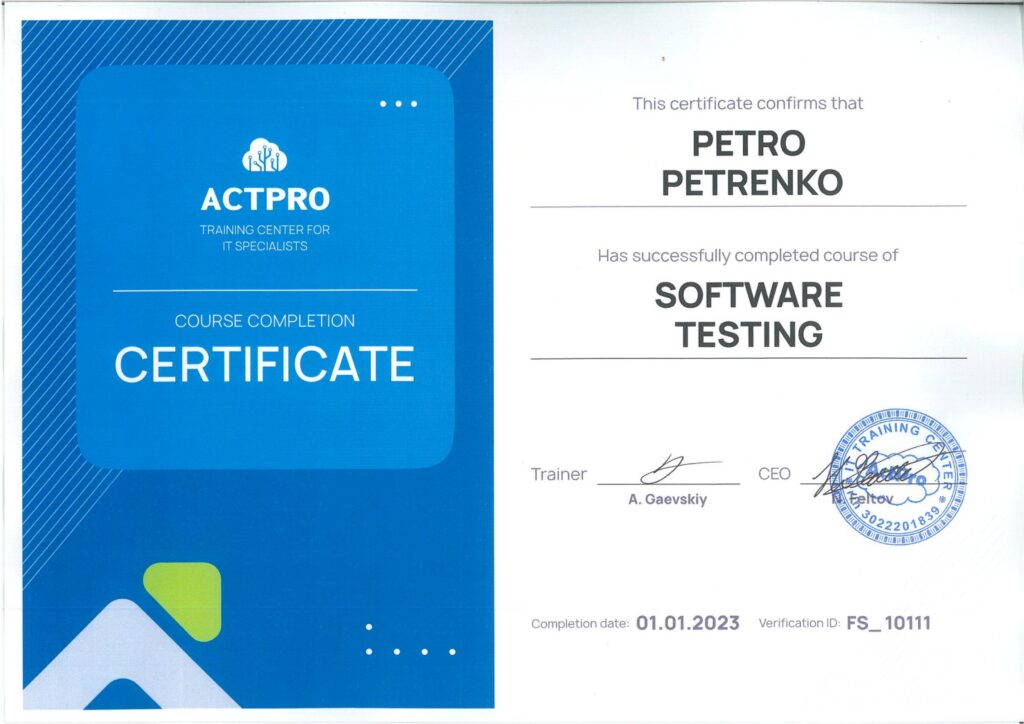TOP CHOICE
NEW COURSE
FULL ONLINE
WE PROVIDE RECORDINGS OF ALL LESSONS
QA course. Software testing
There are still a few places left: 5
QA is the most popular area of work in IT among beginners and those who are changing their current profession to an IT specialist

Duration
3 months | 33 lessons
Start date
September 25
Course fee
to secure your place in the group you must make an advance payment of 1000 UAH

Help
with job search

No experience required
Course
«IT English»
course as a gift

There are only 10 students in the group

Relevance of the profession
A tester is an IT company specialist whose task is to find errors and control the quality of sites, applications, interfaces, etc. That is, the tester tries on the role of the site user and evaluates the ease of use.

We used to be like everyone else -
still used that tech class of 20 people in a group.. But we noticed that the percentage of employed students has decreased.
This can be explained by several reasons: firstly, unfortunately, the situation in the country, and secondly, there are many one-day courses that promise a lot but deliver little.
And now everything is different
We have decided to radically change the training policy of our courses and make learning as effective as possible.
That’s why we offer semi-individual training in a group of 10 people.
Students receive more materials and tools
They practice and learn the material better
Get their dream job in the shortest possible time

Our students work in international IT companies

After completing the course you will:
Understand different software development methodologies and the role of QA in them;
Be able to create and maintain test documentation;
Know how to perform quality control of different types of projects;
Know the basic technical aspects of QA (automation, performance, API testing, etc.);
Be able to successfully answer basic technical interview questions.
What tools are we learning?

Course program:
- Why do you need to test applications?
- Basic definitions and axioms of testing.
- The concept of software quality. Software quality standards.
- Attributes and characteristics of software quality. Software life cycle.
- Agile development methods. Goals and objectives of the testing process at each stage of development.
- Full testing cycle. Phases of testing.
- Methods and types of testing. General overview.
- Criteria for testing coverage. Requirements coverage.
- Analysis of requirements in terms of suitability for testing.
- Test plan.
- Test design.
- Possible forms of test design preparation.
- ISO 29119 standard
- Definition of Test Case, Check list.
- Writing rules, degree of detail, independence.
- Rules for describing defects, the concept of importance, priority.
- Maintaining a defect tracking system.
- Reporting on test results.
- Practice: creating a checklist of test cases.
- Coverage of input data.
- Equivalent partitioning.
- Limit value analysis.
- Pairwise combination.
- Assumption of errors.
- What is a bug tracking system. (Jira, Bugzilla, Mantis, etc.).
- TestRail.
- Functional testing.
- Security and Access Control Testing.
- Interoperability Testing.
- Non-functional types of testing.
- Smoke Testing
- Regression Testing
- Tasks and goals of user interface testing.
- Functional testing of the user interface.
- Testing the usability of the user interface.
- Testing of web applications.
- CRUD.
- Practice: functional testing of the GUI. Team practical training.
- Document Object Model.
- HTML elements.
- Working with CSS. Creating a web page.
- Installing and configuring GIT.
- Basic GIT commands.
- Working with GIT BASH. Creating, cloning, committing, and merging branches.
- Setting up .gitignore.
- Client – server architecture. HTTP methods.
- Postman vs Soap UI.
- JSON, XML, WSDL.
- Xpath, CSS selectors and dynamic locators.
- DEV tool.
- Selenium WebDriver. Writing and running autotests. Page Object and its application.
- Specifics of mobile application testing.
- Basic practices for testing mobile applications.
- Structured query language is a language of structured queries. No technical interview is complete without questions about this language.
- SQL injections.
- XSS injections.
- HTML injections.
- Interception of requests.
- Installing and configuring Apache Jmeter.
- The main metrics of load testing.
Assertions. - Load testing without data.
- API testing with Jmeter.
- The basics of virtualisation.
- Introduction to OC Linux based on the Ubuntu distribution.
- Fundamentals of networking
- Types of companies and why you need to know
- How to look for a job
- Useful resources and social networks
- The structure of a resume
- Where to start
- What is better not to indicate
- Cover letter
- Called for an interview, what to do
- The day of the interview
- Discussion of issues that have arisen regarding the finished CV
- Pitch (structure and logic)
- Hiring process in companies
- Common questions at interviews
- How to get rid of fears
- Summing up the results.
- Examination.
The course programme is based on 3 pillars:
Grammar: Passive Voice and Modal Verbs
Without understanding and confident use of these topics, competent writing of technical documentation and business correspondence is impossible.
Vocabulary: Must Have for IT specialist, IT Terminology, Irregular Verbs
After completing the course, students will be able to read and understand IT articles without a dictionary. During the classes, students not only read and translate IT texts, watch training videos and work with flashcards, but also practice their spoken English in dialogues and by answering questions from the teacher. The emphasis is on moving as many words as possible from passive to active vocabulary.
Preparation for the Job Interview:
Many hours of the course are devoted to preparing for the student’s upcoming job interview. We analyse the most frequently asked technical and personal questions and prepare and learn answers to them. At the end of the course, you will have a test of your knowledge and a “rehearsal” of a real interview.
Sign up for this course now!
Andrew
Very good Manual QA course, excellent teacher Olga and English teacher Antonina. Structured…
Very good Manual QA course, excellent
Marina
Ovcharenko
Have a good time everyone! I just finished the software testing course. I want to thank ActPro School for…
Have a good time everyone! I just finished the software testing course.
Mykola
Moiseev
Good day everyone, thanks to ActPro courses for qualified training, for good technical knowledge and…
Good day everyone, thanks to ActPro courses
Kateryna
Monakhova
I graduated from the QA course in September 2020. A job offer has already arrived. Impressions of the course are positive…
I graduated from the QA course in September 2020…
Frequently asked questions
We think so, if you devote at least 10 hours a week to classes, do your homework, and communicate with your mentor. Then in 3 months, you will be able to master the skills of a tester, build a portfolio of projects, and start your career.
You just need to be an experienced PC user to get started.
No, you don’t. Our course is designed for those who have never worked in IT and have no idea about testing. We don’t require any programming knowledge at the initial stage. The programme is structured in such a way that you will acquire the skills of a professional tester while you are taking the course. If you have basic knowledge, the course will help you structure it and move on.
It is possible, in order to secure your place in the group, you need to pay 1,000 hryvnias before the start of training, then 7,000 hryvnias at the first lesson and the remaining amount (7,000 hryvnias) no later than the 10th lesson.
We make a video recording of each class, and you will also have access to the class summary and other course materials.
Yes, you can become a tester without knowing English, but this will limit your choice of companies and projects.
Definitely yes. Our course includes English lessons, which are included in the tuition fee. You can also learn English at the same time while studying at the course. To do this, it is best to take individual lessons with a tutor. As a result, in 3 months you will have learnt a relevant IT profession and will be able to raise your English level by one level.
Developers and testers may come from different backgrounds, but English is what unites them. To get into serious projects, you need to know English. Otherwise, you simply won’t be able to write a quality report on the defect found or communicate with the customer.
You do not need to have a state-of-the-art computer or laptop to take the course. Computer requirements for the course: RAM from 4 GB, intel core i3/i5/i7 processor, preferably not younger than the 3rd generation (or equivalent from AMD), free hard drive space of about 20 GB, operating system of your choice: Windows/Linux/MacOS.
All lecturers are practitioners at least at the Senior level, with at least 5 years of experience in leading companies.
You can contact the administrator by filling out the form on the website, or call any of the contact numbers or write to the messenger listed on the website. If possible, you can also come to our office to discuss all the details of the course. You can also request a prepayment invoice online.
If you have a chance, read Savin’s old book :). The link to download the book is below.











